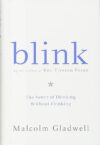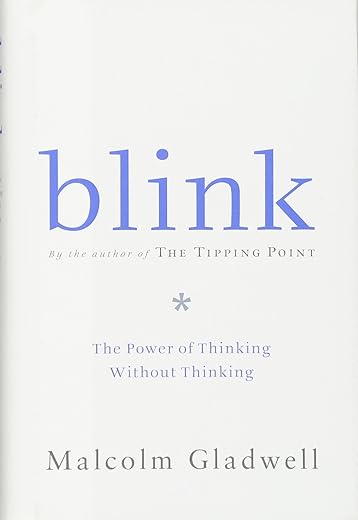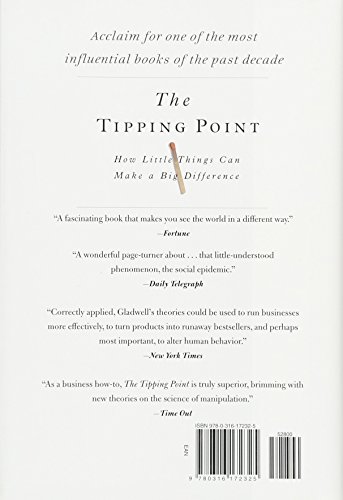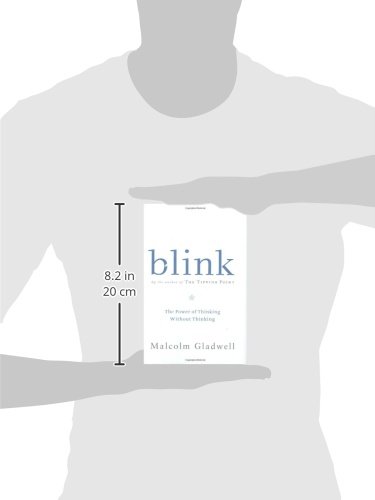
$3.99
Blink: The Power Of Thinking Without Thinking By Malcolm Gladwell Price comparison
Blink: The Power Of Thinking Without Thinking By Malcolm Gladwell Price History
Blink: The Power Of Thinking Without Thinking By Malcolm Gladwell Description
Discover “Blink: The Power of Thinking Without Thinking” by Malcolm Gladwell
Are you ready to challenge your understanding of intuition and decision-making? “Blink: The Power of Thinking Without Thinking” by Malcolm Gladwell offers a transformative exploration of our subconscious mind and its impact on the choices we make. Published by Little, Brown and Company, this first edition hardcover is a must-read for anyone interested in psychology, sociology, or just improving their decision-making skills.
Key Features of “Blink”
- Insightful Content: With 288 pages packed with research and anecdotes, Gladwell explores how we often make snap decisions that can be as good as or even better than those made after extensive deliberation.
- Authoritative Voice: Malcolm Gladwell is a highly respected author known for his ability to weave compelling narratives around complex theories, making them accessible to a wide audience.
- Engaging Format: This hardcover edition is elegantly designed and easy to navigate, making it an attractive addition to any bookshelf.
- ISBN Details: ISBN-10: 0316172324, ISBN-13: 978-0316172325, ensuring you can easily find and reference this important work.
- Weight and Dimensions: Weighing 2.31 pounds and measuring 5.8 x 1.25 x 8.35 inches, this book is ideal for both home and office settings.
Why You Should Read “Blink”
By diving into “Blink,” you’ll gain profound insights into the mechanisms behind your own thought processes. The book explores the concept of “thin-slicing,” or the ability to take a small amount of information and make a quick, accurate judgment. Gladwell illustrates this idea through fascinating case studies ranging from art to warfare, helping readers understand how to read situations and people more effectively.
Comparative Pricing Across Retailers
When looking for “Blink: The Power of Thinking Without Thinking”, you’ll find a variety of prices across different retailers. We encourage you to compare prices to ensure you find the best deal. As of now, prices range from $14.99 to $25.95 depending on the retailer, edition, and condition (new vs. used), which makes it an accessible investment for readers.
Price Trends From the Past 6 Months
Our 6-month price history chart shows that prices for “Blink” have fluctuated, often dropping during seasonal sales events. The lowest recorded price in the last few months was $14.99 during a promotional sale, indicating that you should keep an eye out for such deals.
Customer Reviews: What Readers Are Saying
Customer reviews of “Blink” highlight its thought-provoking nature. Many readers love Gladwell’s engaging storytelling style, which blends research with relatable narratives. They appreciate how he challenges traditional views of how we make decisions. Readers often note the clarity of his arguments and the practical applications for understanding everyday choices.
However, some reviewers mention that while the examples are intriguing, some aspects feel overly generalized. Others would have liked more detailed explanations of the psychological studies referenced. Despite these minor drawbacks, the overall reception remains overwhelmingly positive, making it a recommended read for those curious about the subconscious.
Explore Unboxing and Review Videos
If you’re eager to learn more about “Blink,” consider checking out related unboxing videos and detailed reviews available on YouTube. These videos provide a closer look at the book’s content and presentation, along with insights from other readers to assist you in your decision-making process. Watching these videos can enhance your understanding and appreciation of the book, making your reading experience even more rewarding.
Final Thoughts
In a world where decisions are made in fractions of a second, “Blink: The Power of Thinking Without Thinking” stands out as a pivotal read. Malcolm Gladwell’s work challenges you to reconsider how you approach the choices you make daily. Whether you are a student, a professional, or simply a curious reader, this book is an invaluable resource.
Don’t miss your chance to delve into the fascinating world of intuitive thinking. Compare prices now! Whether you prefer purchasing from a local bookstore or an online marketplace, this insightful book is just a few clicks away.
Blink: The Power Of Thinking Without Thinking By Malcolm Gladwell Specification
Specification: Blink: The Power Of Thinking Without Thinking By Malcolm Gladwell
|
Blink: The Power Of Thinking Without Thinking By Malcolm Gladwell Reviews (8)
8 reviews for Blink: The Power Of Thinking Without Thinking By Malcolm Gladwell
Only logged in customers who have purchased this product may leave a review.










S Dutta –
This book is completely gripping through the entire duration. Absolutely worth a read for anyone who loves a unique book.
JGPavanelli –
Além de trazer ideias muito interessantes, é uma leitura que flui com leveza. Não tem como não ler.
José –
Compré este libro como un auto regalo de Navidad, no lo he terminado, lo que llevo hasta ahorita me parece muy reflexivo e interesante. Su tamaño es adecuado para llevarlo a casi todas partes; no es aburrido su contenido y tiene buen precio.
V.V. –
Gladwell-typisch leicht lesbar, interessant und humorvoll. Die in “Blink” vorgestellten Studien regen durchaus zum Nachdenken an und die Lektüre ist für jedermann empfehlenswert, gerade für Menschen, die im Sozialbereich arbeiten (wollen) besonders spannend.
Dieses Exemplar habe ich als Geschenk gekauft. Es kam in einwandfreiem Zustand an und hat den Beschenkten gefreut.
Elmer Diaz 2 –
As expected, this is another easy read, well-researched, and written by Malcolm Gladwell. Fascinated by the power of a blink when we make instant decisions and why
Brecon –
Blink is another thought-provoking book by Malcolm Gladwell that examines the power of our subconscious minds to make quick and accurate judgments. Gladwell argues that sometimes, our intuitive decisions are more reliable than those based on deliberate thought.
Key themes and concepts:
The power of intuition: The book explores how our subconscious minds can process information rapidly and make accurate judgments without conscious deliberation.
The dangers of overthinking: Gladwell argues that excessive analysis can sometimes lead to poor decision-making.
The importance of context: The book emphasizes the role of context in shaping our intuitive judgments.
Examples explored in the book:
The ability of experts to make quick and accurate judgments based on a brief glance
The role of intuition in interpersonal relationships
The challenges of making decisions based solely on conscious thought
Why this book is important:
Understanding decision-making: Blink provides valuable insights into the complex ways in which our minds make decisions.
Practical applications: The concepts presented in the book can be applied to various fields, including business, leadership, and personal relationships.
Engaging storytelling: Gladwell’s writing style is engaging and accessible, making complex ideas easy to understand.
If you’re interested in learning more about the power of the subconscious mind and the art of decision-making, Blink is a fascinating read.
Reading Fan –
`Blink’ is about the mysterious two seconds it takes to develop a first impression and how surprising the impression often is, given our known preferences and tendencies. Malcolm Gladwell got the idea for this book after he had let his hair grow long on a whim, and found he was getting speeding tickets for the first time in his life. He wondered why the cops all of a sudden had an impression of him that wasn’t there before. He became curious: where do first impressions come from anyway?
Gladwell does some interesting investigative work to try to get some answers to that intriguing question. He suggests that `rapid cognition’ is behind a `closed door’ in our minds and follows certain unwritten rules. It is a logical process that he feels is not instinctual, but, surprisingly, can be more accurate than deliberate, rational thought, and follows certain rules that we are not even aware of. (Even improvisational comedians follow certain rules, though what they do often seems so random.) One must be careful though, since stereotyping and the immediate environment at the moment can influence the impression. All of this mental background action is going on without our even knowing it! The `closed door’, it turns out, can only be peaked into.
There are lots of very good examples of `blink’. There is the case of the statue that didn’t look right to experts at first glance. Fourteen months later, after much testing, it was discovered by other experts that the statue was a forgery. Then there was the case of the supervisory fireman who yelled to his men to leave the building immediately minutes before it collapsed; he sensed something was wrong when it was not at all obvious what it was. Another example has to do with internationally known and respected tennis instructor who can almost invariably tell when a pro will double-fault just before the serve is hit, and he doesn’t know how he does it! Speed dating often shows people being attracted others that do not fit their criteria of what they are looking for, for reasons they are fuzzy about. All of this is very mysterious, to say the least.
Information and understanding are not the same things and sometimes less information is better. He gives very good examples of this in the medical and military fields. He talks about the `power of the glance’, the ability of a great general to look at a battle field, weed through all the information, and make a rapid decision; he gives a great example of this in Lee’s improbable victory at Chancellorsville. “Sometimes, we have to edit” our information down to something manageable, and make a decision on that. This was very counter-intuitive to me, and I’m sure, something to approach with caution. But I can’t argue against results and he gives good evidence that it works.
Be aware that first impressions can be misleading. Spontaneous decision making is shown to be not infallible, and can even be dangerous at times; stereotyping can supplant logical decision-making in a time-crunch. He goes into some detail about this with an instructive example of a police action in the Bronx that went awry. Gladwell said in the interview at the end of the book that he tried very hard to make this point. Rapid cognition can be your enemy as well as your friend. Use it with caution.
It is tricky knowing how to measure the value of a product or a performer. Packaging can count too much, a great example of which is what he calls the `Warren Harding Error’, a fascinating section of the book. Also, when surveying the response to a product, an opinion can’t always be comfortably expressed in words (except by the experts), and as a result, some people will tend to look for a plausible reason, and give an incorrect opinion. The mystery of why someone likes something can’t always be codified.
This was a fascinating book that does not pretend to give all the answers but does raise some really good questions about a mysterious and important subject. The so-called `locked door’ is finally getting its due.
Argo Dalapati –
“Blink” is a book about our cognitive abilities. Malcolm Gadwell considers the ability of the human mind to make split second decisions and judgments, which are usually accurate. He delves into the idea that our instincts are usually correct, even though there are no fundamental reasons why then goes onto convince readers that snap judgement and first impressions can be controlled and educated. He writes about the term “thin slicing” to describe the ability to find patterns in events based only on narrow windows of experience.
Overall “Blink” provides a new sort of perception that first impressions and judgments are actually true. From childhood, we are all taught that first impressions are key. Malcolm Gadwell provides evidence of split second Decisions and judgement ranging from a retired tennis player, to Medical Doctors. Gadwell does however, explain that prejudices can impair our thoughts. Gadwell even describes how the outcome of a relationship (Divorce or Married) in 10 years, can be quantitatively measured.
The overall theme is “Thinking without Thinking,” which describes that ones mind can subconsciously understand and analyze a situation before one’s conscious takes place. The mind can conceive the details through a situation due to the associates made through society. Gadwell jumps between stories as a describes different topics such as priming, selective processing and expertise, but always relates back to the topic of thin slicing. His writing style leaves the reader curious as to why and how something happens, subconsciously urging them to read on till he abruptly explains the relationship.
The overall book was a pleasure to read, yet I still remain skeptical about some of the ideas and presented. He present’s ideas that have many different outcomes, such as how an artists who should have made it big didn’t and how a commander beat his opponents in a war-game exercise. The book hits individuals with facts and then goes on to describe the relationships found within those statements and facts. I remain skeptical about some of the ideas because they simply seem implausible and rather controversial. Since the earliest days of our birth, we are taught never to make judgments or to judge a book by its cover. Blink teaches us something different, describing how it is alright to judge a book by its cover, and how those judgments actually save us a tremendous amount of time.
Gadwell relies mainly on anecdotal evidence. Each section tells a story about someone who illustrates his theory of snap judgments. The first story presented was about a Greek statue the J. Paul Getty Museum had agreed to purchase. Just before the transaction was about to take place, two art experts immediately knew it was a fake. They had no idea why, or how they just “knew.” Eventually it was found out that the statue was a fake and when a scientist tested a sample of the stuate, Gadwell explains that “In the first two seconds of looking–in a single glance–they [the critics] were able to understand more about the essence of the statue than the team at the Getty was able to understand after fourteen months.” As the book progresses, much more of this intuitive knowledge is proven to be true.
The main problem in the book is that some of the information is presented in a falsify way. The readers are not given completely background of all the other possibilities. In one example, Gadwell explains how artist by the name of Kenna, is loved by artists, managers, and talent scouts but fails to make it in the big run because radio stations dislike him because he didn’t market himself properly to them. Individual people thin sliced Kenna and realized he was good, but radio stations waited some time to make a rational judgment which in turn led them denying him. Gadwell explains that Kenna could either have been promoted, or the radio stations are wrong, but never does he touch on the fact that Kenna might have been a bad artist.
I would highly recommend this book to other readers, simply because of the way it makes you think about your judgments. I was able to finish this book within a day because of the intriguing logic Gadwell uses to prove his point. This book made me step back and think “Wow. Can that be true.” It truly made me think of the decisions I make on a daily basis, and how some of those decisions are already determined. While I do remain skeptical about some of the idea’s presented in the book, the overall book was a pleasure to read; keeping me entertained and curious enough to finish the entire book. I enjoyed the book enough to go and purchase Malcolm Gadwell’s other book “The Tipping Point.”
Overall, read it and enjoy how much it makes you think. One should not however take everything said in the book to be the truth.